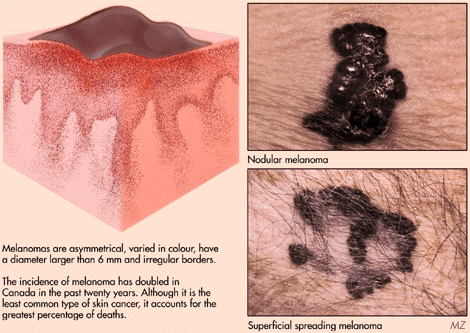Michelle Durkin, BSc
The most common form of cancer today is skin cancer. Approximately half of all new cancers diagnosed are one of three defined types: basal cell carcinoma (BCC) , squamous cell carcinoma (SCC), or malignant melanoma (MM). Although the age of diagnosis is decreasing, most skin cancers do not appear until after the age of fifty, making this disease a serious threat to the elderly population. Fortunately it is also a disease which is successfully treated if detected early.
Epidemiology
The incidence of nonmelanoma (BCC and SCC) and MM skin cancers has increased so significantly over the past few decades it may have reached epidemic proportions, particularly in the United States and Canada. It has been projected by the National Cancer Institute along with the Center for Disease Control that in 1999 alone, skin cancer (all types combined) will claim the lives of nearly 9,200 people in the United States. Besides increasing annual incidence, more women are getting skin cancer and people are getting skin cancer at younger ages.

Individual types of skin cancer follow different morbidity and mortality distributions. About 80% of skin cancers are BCC, 16% SCC, and 4% MM. The mortality rate for nonmelanoma skin cancer is decreasing and that of melanoma is increasing.

